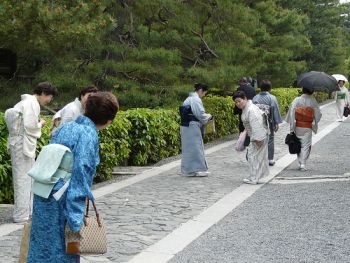Japanese Greeting Customs
People in Japan greet each other by bowing. When you meet a person you should bow and that way show respect. When doing so your palms should be on your thighs or at the lap. Your heals should be put together. According to the angle the body makes there are three types of bowing – “eshaku” or greeting bowing – 5 degrees, “futsuu rei” or respect bowing – 30 degrees and “saikei rei” or highest respect bowing – 45 degrees. Longer and deeper bowing is present at more formal occasions.
 Japanese women bowing
Japanese women bowing
A bow of 45 degrees is believed to be proper for any occasion. The bow should last for some two seconds. Like in every rule there are exceptions. A person praying will stay bowed until he/she is finished his/her prayer.
Let's imagine the situation when you meet someone several times a day. You should bow every time you meet the person. When you are attending some informal meeting a nod or lifted either hand will do just fine. It has to be said that there is no physical contact between you and the person you are greeting.
Bowing is present to only as form of greeting. The Japanese perform it as an act of apology. If someone causes a serious offence he/she should bow deeper and more frequently. When a person wants to express the deepest apology he/she makes a kneeling bow when his/her forehead touches the floor.
You should always address a person as Mr. or Mrs. This is done by adding word San to the surname. This is not done with children. Women call each other by their name if they are friends, co-workers or at the informal meetings. Men do it only if their relation is personal or in informal situation. As result of western influence young people or generally people in cities also use handshake or which is more common combine it with a bow. Never offer a handshake. Wait for the other person to offer it.